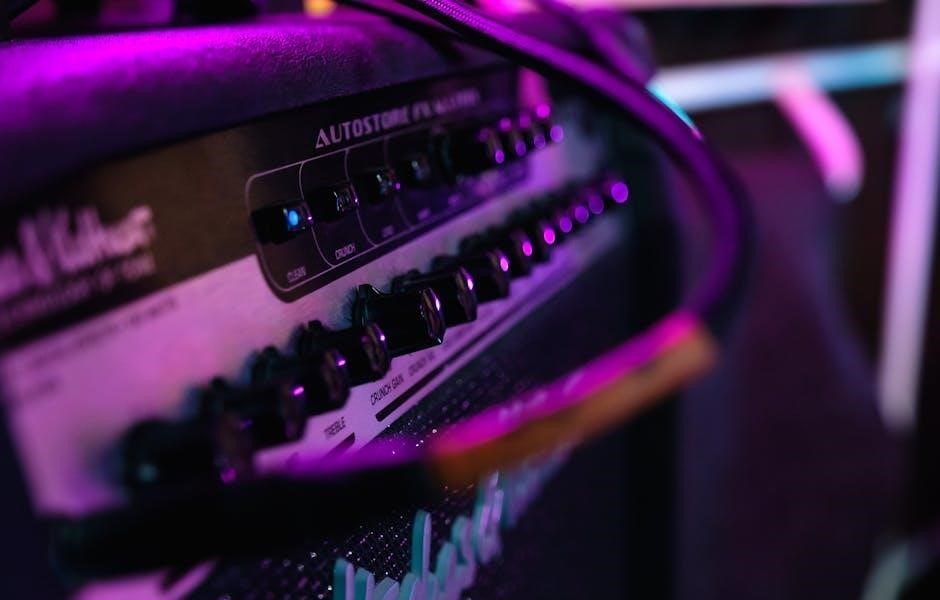
bass arpeggios pdf
Bass arpeggios are a fundamental concept in music‚ involving the playback of chord notes in a sequential manner. They enhance musical understanding and technical proficiency‚ offering a structured approach to learning scales and chords. With numerous PDF resources available‚ such as “Bass Guitar Scales‚ Chords & Arpeggios” and free downloadable guides‚ players can access comprehensive lessons and exercises to master arpeggios effectively.
What Are Arpeggios?
Arpeggios are musical patterns that play the notes of a chord in sequence‚ rather than simultaneously. They are essential for bass guitarists‚ as they help build technique and enhance musical understanding. Available in PDF formats‚ resources like “Bass Guitar Scales‚ Chords & Arpeggios” provide detailed exercises and charts to master these fundamental patterns‚ making them indispensable for both beginners and advanced players.
Importance of Arpeggios in Bass Guitar
Arpeggios are vital for bass guitarists‚ improving technical skills and musicality. They enhance chord tone accuracy‚ strengthen finger independence‚ and deepen harmonic understanding. PDF resources like “Bass Guitar Scales‚ Chords & Arpeggios” offer structured exercises‚ making arpeggios accessible for all skill levels and essential for building a solid foundation in bass playing‚ whether for composition‚ improvisation‚ or performance.

Types of Bass Arpeggios
Bass arpeggios include major‚ minor‚ dominant‚ and diminished varieties‚ each with distinct tonal qualities. PDF guides like “Bass Guitar Scales‚ Chords & Arpeggios” detail these types‚ offering clear patterns and exercises for mastery.
Major Arpeggios
Major arpeggios are built from the root‚ major third‚ and perfect fifth‚ creating a bright‚ harmonious sound. They are fundamental for bassists‚ often used in various musical genres. PDF resources like “Bass Guitar Scales‚ Chords & Arpeggios” provide detailed diagrams and exercises‚ helping players master these arpeggios across the fretboard with clarity and precision.
Minor Arpeggios
Minor arpeggios consist of the root‚ minor third‚ and perfect fifth‚ creating a somber‚ melodic sound. These arpeggios are essential for bassists‚ commonly used in various musical styles. Resources like Bass Guitar Scales‚ Chords & Arpeggios offer detailed patterns and exercises‚ allowing players to master minor arpeggios efficiently across the fretboard. They are versatile for both composition and improvisation.
Dominant Arpeggios
Dominant arpeggios‚ comprising the root‚ major third‚ and diminished fifth‚ add a rich‚ complex texture to music. These arpeggios are widely used in jazz and rock‚ offering a full‚ dynamic sound. Resources like Bass Guitar Arpeggios PDF provide exercises and patterns for mastering dominant arpeggios‚ enhancing both technique and musical versatility for bassists seeking to expand their harmonic capabilities effectively.
Diminished Arpeggios
Diminished arpeggios consist of a root‚ minor third‚ and diminished fifth‚ creating a tense‚ dramatic sound. Often used in jazz and fusion‚ they add complexity to solos and compositions. PDF resources like “Arpeggios for 4-String Bass” offer detailed exercises‚ helping bassists master diminished arpeggios and incorporate them into their playing for a unique harmonic edge and emotional depth in their music.
Benefits of Learning Bass Arpeggios
Learning bass arpeggios enhances musicality‚ boosting technical skills and versatility. They improve improvisation and composition abilities‚ while PDF resources offer exercises and charts for effective practice and mastery.
Enhanced Musical Understanding
Learning bass arpeggios deepens your grasp of chord structures‚ intervals‚ and scale relationships. By breaking chords into individual notes‚ arpeggios help identify chord tones‚ enabling better improvisation and composition. This understanding enhances your ability to play in various keys and styles‚ connecting scales and chords seamlessly. PDF resources provide visual charts‚ simplifying the learning process and reinforcing musical theory concepts effectively.
Improved Technical Proficiency
Mastering bass arpeggios strengthens finger independence‚ dexterity‚ and coordination. Regular practice enhances accuracy and speed‚ allowing smooth transitions across the fretboard. These exercises also improve string skipping and alternate picking techniques. PDF resources like “Bass Guitar Scales‚ Chords & Arpeggios” offer structured workouts‚ helping build a strong technical foundation for versatile and confident playing across various musical styles.

How to Practice Bass Arpeggios
Begin with slow tempos‚ focusing on clean notes and proper finger placement. Gradually increase speed as accuracy improves; Use PDF guides for structured exercises and consistent progress.
Starting with One-Position Arpeggios
Mastering one-position arpeggios is essential for bassists. Begin with common chords like C Major and A Minor. Use PDF resources to find diagrams and exercises‚ ensuring proper finger placement and note clarity. Practice slowly‚ focusing on accuracy and smooth transitions between notes to build a solid foundation before advancing to more complex patterns and positions.
Building Speed and Accuracy
Gradually increase speed using a metronome while maintaining clarity. Start with slower tempos and focus on clean note transitions. Practice scales and arpeggios in various keys using PDF guides to ensure consistency. Incorporate backing tracks for real-world application and rhythm precision. Regular‚ focused practice will enhance technical skill and overall musical performance effectively.
Bass Arpeggios PDF Resources
Discover a wealth of free downloadable PDFs and detailed manuals for mastering bass arpeggios. These resources include comprehensive guides‚ exercises‚ and chord charts to enhance your learning journey. Popular books like Bass Guitar Scales‚ Chords & Arpeggios offer structured lessons for all skill levels‚ ensuring a solid foundation in arpeggio techniques.
Free Downloadable PDFs
Access a variety of free downloadable PDFs specifically designed for mastering bass arpeggios. These resources often include one-position arpeggios for common chords‚ such as Major‚ Minor‚ Dominant‚ and Diminished‚ along with exercises to improve technique. Websites like onlinebasscourses.com and joshfossgreen.com offer detailed guides‚ ensuring players of all levels can practice effectively and expand their musical knowledge.
Recommended Books and Manuals
For in-depth learning‚ consider books like Bass Guitar Scales‚ Chords & Arpeggios and The Bass Arpeggio Reference Manual. These resources provide comprehensive guides‚ detailed exercises‚ and practical applications for mastering arpeggios. They cater to both beginners and advanced players‚ offering structured lessons to enhance technique and musical understanding. These manuals are essential for serious bassists aiming to refine their skills.

Common Mistakes to Avoid
Common mistakes include playing out of time and having inconsistent tone. Rushing through exercises and neglecting proper fingering techniques can hinder progress; Stay focused on rhythm and clarity.
Playing Out of Time
Playing out of time is a common mistake that disrupts rhythm and timing. It often occurs due to rushing or inconsistent practice. To avoid this‚ use a metronome to maintain steady tempos and practice arpeggios slowly before increasing speed. Focus on syncing with backing tracks or drum machines to enhance timing accuracy and overall musicality. Consistency is key to mastering rhythm effectively.
Inconsistent Tone
Inconsistent tone is a common issue‚ affecting the clarity and professionalism of bass playing. It arises from uneven finger attack‚ improper string selection‚ or poor technique. To address this‚ practice with a focus on uniform dynamics and articulation. Utilize PDF resources like “Bass Guitar Scales‚ Chords & Arpeggios” for targeted exercises. Regular practice with metronomes and backing tracks can help maintain consistent tone and enhance overall musicality.
Role of Arpeggios in Music
Arpeggios are essential for creating harmonic structures and melodic lines‚ serving as a foundation for composition and improvisation. They provide a clear framework for understanding chord progressions and musical harmony‚ making them indispensable in both classical and modern music. PDF resources often highlight their importance in developing musicality and technical skills for bassists.
Composition and Improvisation
In composition‚ arpeggios provide harmonic structure and melodic flow‚ allowing bassists to craft intricate lines. For improvisation‚ they serve as a versatile tool‚ enabling spontaneous creation over chord progressions. PDF guides like “Bass Guitar Scales‚ Chords & Arpeggios” offer exercises that bridge theory with practical application‚ helping musicians integrate arpeggios seamlessly into their playing‚ enhancing both creativity and technical precision in real-time performances.
Popular Music Usage
Arpeggios are extensively used in popular music to create dynamic basslines and solos. Many rock and pop songs rely on arpeggio patterns for their rhythmic and harmonic foundation. PDF resources highlight common arpeggios found in these genres‚ providing players with practical examples to replicate and adapt in their own music‚ ensuring versatility and a professional sound in various musical settings.
Bass Arpeggios and Scales
Bass arpeggios are closely tied to scales‚ as they are built from chord tones within specific scale degrees. PDF resources often include scale charts alongside arpeggio patterns‚ providing a visual connection between the two. This integration helps players understand how arpeggios fit within musical structures.
Relationship Between Arpeggios and Scales
Arpeggios are derived from scales‚ specifically the notes of a chord within a scale. For example‚ a C major arpeggio consists of the root‚ third‚ and fifth notes of the C major scale. PDF resources often illustrate this relationship with diagrams‚ showing how arpeggios are constructed from scale degrees. This connection helps bassists understand harmonic structure and improvisation.
Using Arpeggios in Solos
Arpeggios add depth and melodic interest to bass solos by outlining chord progressions. Players can use PDF guides to learn arpeggio patterns for common chords‚ enabling them to create solos that align with harmonic structures. This technique enhances musicality and provides a framework for improvisation‚ making solos more engaging and cohesive.

Bass Arpeggio Exercises and Etudes
PDF resources offer a variety of exercises and etudes tailored for bass arpeggio practice. These structured lessons cover basic patterns to advanced techniques‚ helping players refine their skills and expand musical versatility through focused study and repetition.
Simple Exercises for Beginners
Beginners can start with one-position arpeggios‚ focusing on common chords like C Major and A Minor. PDF guides provide clear diagrams and patterns‚ ensuring a smooth learning curve. These exercises emphasize playing cleanly and in time‚ building finger strength and familiarity with the fretboard. Regular practice helps establish a solid foundation for more complex techniques later on.
Advanced Etudes for Experienced Players
Experienced players can explore intricate etudes that combine arpeggios with complex rhythms and scales. PDF resources offer advanced exercises like 7th chord arpeggios and modal interchange. These etudes challenge technique and musicality‚ encouraging improvisation and composition. They also provide a framework for developing unique solos and expanding harmonic knowledge‚ pushing the boundaries of bass playing to new heights effectively.
Tips for Mastering Bass Arpeggios
Set achievable goals‚ practice consistently‚ and use tools like metronomes to improve timing. Focus on finger independence and tone quality for a polished sound. Stay dedicated and patient.
Setting Achievable Goals
Setting specific‚ measurable goals is crucial for mastering bass arpeggios. Start with one-position arpeggios‚ gradually increasing complexity. Break down exercises into smaller sections‚ focusing on accuracy and tone. Use PDF resources to track progress and identify areas needing improvement. Regular review and adjustment of goals ensure steady development and maintain motivation throughout the learning process.
Using Metronomes and Backing Tracks
Metronomes and backing tracks are invaluable tools for refining bass arpeggio technique. A metronome ensures precise timing‚ helping build speed and consistency. Backing tracks provide a rhythmic context‚ enhancing musicality and versatility. Many PDF resources include exercises designed for use with these tools‚ allowing players to practice efficiently and effectively‚ improving both technical skill and overall performance quality.
Related Posts

acls exam version c answers pdf
Get ACLS Exam Version C answers in PDF format. Free study guide, practice questions, and instant download. Prepare smarter, not harder!

explaining adhd to a child pdf
Learn how to explain ADHD to children in a simple, engaging way. Download our free PDF guide to help kids understand and manage their ADHD.

john paul jackson books pdf free download
Access John Paul Jackson’s books for free in PDF. Instantly download his spiritual teachings and revelations.